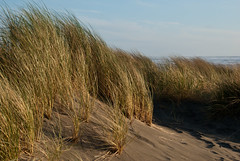 CORVALLIS, Ore. – The removal of invasive beach grasses on the Oregon coast to improve nesting habitat for the western snowy plover, a threatened shorebird, can harm non-target, native plant species and dune ecosystems, an Oregon Sea Grant-supported study shows.
CORVALLIS, Ore. – The removal of invasive beach grasses on the Oregon coast to improve nesting habitat for the western snowy plover, a threatened shorebird, can harm non-target, native plant species and dune ecosystems, an Oregon Sea Grant-supported study shows.
The findings, published by researchers from Oregon State University in Ecosphere, a professional journal, suggest that restoration projects to aid a threatened species should also consider the broader ecosystem in which it lives.
“By just targeting one species, you’re not reestablishing the ecosystem function and allowing the other native species that are also in decline to recover,” said Sally Hacker, an OSU associate professor of zoology. “We looked at the whole process to see if there were ways to help restore things to benefit the plover as well as other species.”
The western snowy plover, a small, open-ground nesting shorebird that prefers bare or sparsely-vegetated, low, sandy dunes, was listed as a threatened species in the early 1990s after populations in Oregon declined to only about 28 surviving individuals.
The listing triggered protection and monitoring, including restoration sites on public land along the Pacific coast. Bulldozers and other mechanical and hand methods were used to remove two invasive beach grass species, Ammophila arenaria and Ammophila breviligulata. These grasses make it difficult for the plover to nest, see predators, and access the open beaches to feed.
The non-native grasses had been introduced in Oregon in the late 1800s and early 1900s to stabilize beach sand that was inundating coastal roadways and homes, and create foredunes to protect properties from winter storm surges.
But the introduced grasses transformed vast stretches of what was once dynamic beach dunes populated by low-growing native plants into dense, static monocultures of the bristly beach grass. The invasive grasses shade out low-growing native plants and have caused continuous foredunes to form at heights of as much as 45 feet.
With support from Oregon Sea Grant, Hacker and Eric Seabloom, a former OSU professor, and doctoral candidate Phoebe Zarnetske, studied 10 of the plover restoration sites.
Read more in:





 The New Zealand mudsnail is an introduced aquatic species that has invaded estuaries, lakes, rivers, and streams in Washington, Oregon, California, and many other states in the western U.S. Its small size (<5 mm), cryptic coloration, and ability to survive out of water for weeks make it an ideal hitchhiker.
The New Zealand mudsnail is an introduced aquatic species that has invaded estuaries, lakes, rivers, and streams in Washington, Oregon, California, and many other states in the western U.S. Its small size (<5 mm), cryptic coloration, and ability to survive out of water for weeks make it an ideal hitchhiker.  Representatives from China’s Fujian Academy of Science-Forestry-Institute of Ecology and Environment are visiting Oregon this week to confer with an Oregon Sea Grant specialist on methods of fighting the spread of an invasive grass species.
Representatives from China’s Fujian Academy of Science-Forestry-Institute of Ecology and Environment are visiting Oregon this week to confer with an Oregon Sea Grant specialist on methods of fighting the spread of an invasive grass species.